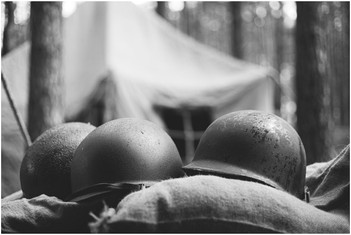Unpacking the Term M1 Bayonet
Jan 10th 2024
The United States Army has used a peculiar nomenclature using the letter “M” for issued equipment such as knives, helmets, ordnance, and weapons.
This can lead to a bit of confusion, as the term “M1” is the first one issued over and over, ad nauseam. Consider M1 Garand, M1 Carbine, M1 Rifle, and M1 bayonet.
These all refer to different things that are all labeled as “M1” for “Model 1.”
Let’s cover the M1 bayonet, as well as where some confusion might arise.
What Is an M1 Bayonet?
Strictly speaking, the M1 bayonet is a shortened version of the M1905 bayonet, which was developed in 1905 for the M1903 Springfield.
The original bayonet, the M1905, was a sword bayonet with a 16” blade and either wooden or plastic grips. Though it was developed for the M1903, it is also compatible with the bayonet lugs on the M1 Garand.
Though it is compatible with the Garand, it is not an M1 bayonet. That term is reserved for its successor, the true M1, which was shortened in 1943 to better equip troops for close quarters combat in WWII.
The theory behind the longer sword bayonets was to equip infantry armed with battle rifles the extra reach they would need to counter a cavalry charge, or at least effectively engage a mounted opponent.
There was still cavalry in WWI, but its influence on the battlefield slowly faded as both the Central Powers and the Allies entrenched themselves into a war of attrition - quite literally.
Sword bayonets are limited in utility in trenches, to be generous with it. Realistically they are useless.
And, even though trench warfare was not a thing predominantly experienced in the Second World War, the Army decided in 1943 that it was time to make a change to the M1905.
So, they cut the blade down to 10”. Most of the companies contracted to provide the Army with bayonets simply recalled issued M1905 bayonets and ground down the blades to 10” before reissuing them. Apparently, as many as a million M1 bayonets were produced in this fashion.
The ground down M1905 bayonets were given either a spear or beak point, and then reissued to troops where, apparently, they performed well in Europe when matched up against the 9.75” bayonets carried by the Germans. With that being said, many Americans in the Pacific Theater of Operations apparently kept using their longer M1905 bayonets, as the Imperial Japanese Forces were still using sword-style bayonets on their Arisaka rifles.
Which Bayonets Are Compatible with the M1 Garand?
While the M1 bayonet was officially issued for compatibility with the M1 Garand, it is not the only bayonet compatible with that rifle.
For one, the M1905 is compatible with the rifle’s bayonet lugs, as has already been mentioned.
After the Second World War, soldiers in the Army stationed in Korea during the Korean War had a hard time fixing and removing their M1 bayonets. As a result, the Army had to go back to the drawing board.
The new design was known as the M5 bayonet. The new bayonet weighed 11.5 oz and had a 6.75” blade, sharpened on one edge and with a false edge along the stop of the spine for a few inches.
The M5 lacks a barrel ring on the crossguard, bearing instead a stud that mounts to the gas cylinder lock screw on the Garand, with locking grooves that attach to the bayonet lugs. It also features a fairly large push button to release it, making it easier to remove while wearing heavy gloves.
Besides these three bayonets, there are a series of scabbards that are compatible with them made of a combination of either metal, wood, canvas, and fiberglass.
Scabbards compatible with the M1 bayonet include the M3 and M7 scabbard.

What About the M1 Carbine?
When the first M1 Carbine was developed, it did not include bayonet lugs. As a result, it was issued without a bayonet, and troops given it were instead issued the M3 fighting knife.
The M3 fighting knife was also issued to other troops who were otherwise not issued a bayonet, or a rifle that could accept one.
A series of requests for a modification to the M1 Carbine to include bayonet lugs caused the Army to redesign it, but the new M1 Carbines issued with bayonet lugs weren’t ready until the end of WWII.
All the same, the new M1 Carbine necessitated the production of a bayonet compatible with it, which resulted in the development of the M4 bayonet, a modification of the M3 fighting knife that could be mounted to the bayonet lugs.
Looking for an M1 Bayonet?
As you can see, there are a number of ways in which the term “M1 bayonet” might be confusing or even misleading. Regardless, we can help answer your questions or help you find what you’re looking for.
Whatever historical curiosity you’re looking for, if it’s militaria or some other related collectible, we’re likely to carry it! Take a look through our surplus firearm collection, check our new weekly gun deals, or contact us at 610-250-3960 if you need help finding it!

